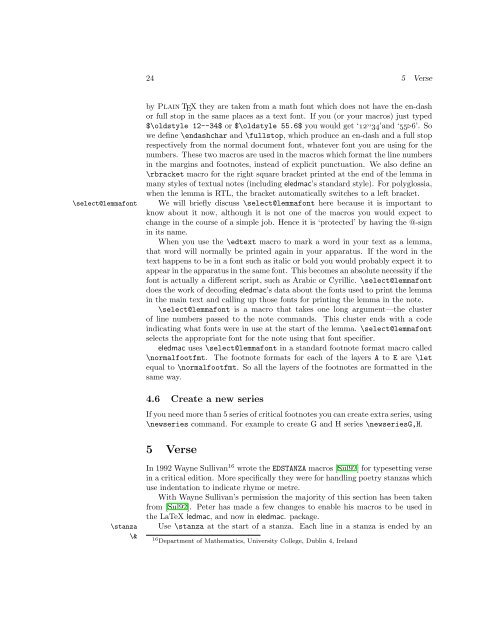eledmac A presumptuous attempt to port EDMAC, TABMAC and ...
eledmac A presumptuous attempt to port EDMAC, TABMAC and ...
eledmac A presumptuous attempt to port EDMAC, TABMAC and ...
You also want an ePaper? Increase the reach of your titles
YUMPU automatically turns print PDFs into web optimized ePapers that Google loves.
24 5 Verse\select@lemmafontby Plain TEX they are taken from a math font which does not have the en-dashor full s<strong>to</strong>p in the same places as a text font. If you (or your macros) just typed$\oldstyle 12--34$ or $\oldstyle 55.6$ you would get ‘12↪↪34’<strong>and</strong> ‘55⊲6’. Sowe define \endashchar <strong>and</strong> \fulls<strong>to</strong>p, which produce an en-dash <strong>and</strong> a full s<strong>to</strong>prespectively from the normal document font, whatever font you are using for thenumbers. These two macros are used in the macros which format the line numbersin the margins <strong>and</strong> footnotes, instead of explicit punctuation. We also define an\rbracket macro for the right square bracket printed at the end of the lemma inmany styles of textual notes (including <strong>eledmac</strong>’s st<strong>and</strong>ard style). For polyglossia,when the lemma is RTL, the bracket au<strong>to</strong>matically switches <strong>to</strong> a left bracket.We will briefly discuss \select@lemmafont here because it is im<strong>port</strong>ant <strong>to</strong>know about it now, although it is not one of the macros you would expect <strong>to</strong>change in the course of a simple job. Hence it is ‘protected’ by having the @-signin its name.When you use the \edtext macro <strong>to</strong> mark a word in your text as a lemma,that word will normally be printed again in your apparatus. If the word in thetext happens <strong>to</strong> be in a font such as italic or bold you would probably expect it <strong>to</strong>appear in the apparatus in the same font. This becomes an absolute necessity if thefont is actually a different script, such as Arabic or Cyrillic. \select@lemmafontdoes the work of decoding <strong>eledmac</strong>’s data about the fonts used <strong>to</strong> print the lemmain the main text <strong>and</strong> calling up those fonts for printing the lemma in the note.\select@lemmafont is a macro that takes one long argument—the clusterof line numbers passed <strong>to</strong> the note comm<strong>and</strong>s. This cluster ends with a codeindicating what fonts were in use at the start of the lemma. \select@lemmafontselects the appropriate font for the note using that font specifier.<strong>eledmac</strong> uses \select@lemmafont in a st<strong>and</strong>ard footnote format macro called\normalfootfmt. The footnote formats for each of the layers A <strong>to</strong> E are \letequal <strong>to</strong> \normalfootfmt. So all the layers of the footnotes are formatted in thesame way.4.6 Create a new seriesIf you need more than 5 series of critical footnotes you can create extra series, using\newseries comm<strong>and</strong>. For example <strong>to</strong> create G <strong>and</strong> H series \newseriesG,H.5 Verse\stanza\&In 1992 Wayne Sullivan 16 wrote the EDSTANZA macros [Sul92] for typesetting versein a critical edition. More specifically they were for h<strong>and</strong>ling poetry stanzas whichuse indentation <strong>to</strong> indicate rhyme or metre.With Wayne Sullivan’s permission the majority of this section has been takenfrom [Sul92]. Peter has made a few changes <strong>to</strong> enable his macros <strong>to</strong> be used inthe LaTeX ledmac, <strong>and</strong> now in <strong>eledmac</strong>. package.Use \stanza at the start of a stanza. Each line in a stanza is ended by an16 Department of Mathematics, University College, Dublin 4, Irel<strong>and</strong>
















